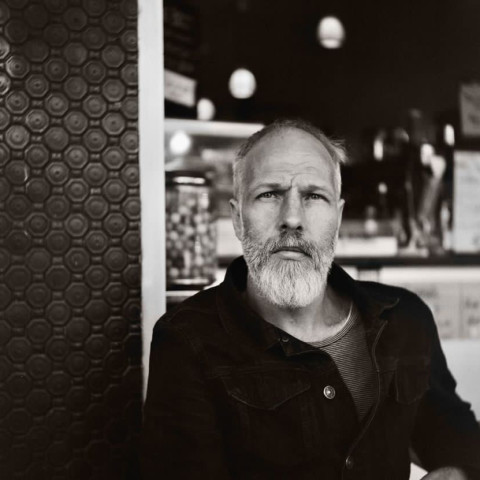
Born 1976, Sydney
Lives and works in Sydney

Our natural world is built on a foundation of unpredictability and beauty, both terrifying and alluring in equal measure. Einstein's theory of Brownian motion, proposed in 1905, describes the random movement of particles suspended in a fluid, resulting from their collision with the fast-moving molecules of the fluid itself. This phenomenon, initially observed by botanist Robert Brown in 1827, provided empirical evidence for the existence of atoms and molecules, and showed that the seemingly random movement of the particles was actually a result of chaotic motion due to thermal energy, and not the liquid itself.
For Chris Horder, this scientific principle translates into the creation of his stain paintings, and the behaviour of his pigments on the canvas. He soaks the canvas in thin washes of handmade watercolours and Indian ink. The process is highly physical, and often involves Horder moving around the canvas, standing over it, and engaging with it on a concrete surface; a method which allows the natural elements—the sun, time of day, humidity, precipitation, and temperature—to influence the drying process. In nature, no two moments are identical. By baking the canvas using heat from the ground, Horder is able to “map” the elements. Their innate properties materialise and become a unique record of the environment in which they were created.
Each painting continues to evolve organically as oils are added, with the first mark setting off a chain reaction that guides the subsequent layers. Horder spends considerable time contemplating each piece, waiting for the moment when the next mark will reveal itself. Without premeditation, the oil becomes an intuitive contribution and extension of the vision he sees in the stains. As Horder layers oil over stain, his art becomes a palimpsest of intention and chance, a testament to the interplay between human and nature. As each mark reveals itself, the stains begin to sing. It is a constant evolution with Horder at the helm—he is the facilitator of watercolour, and master of the oil.
Pulled directly from his poetry, "The Fruits of Spring and the Bats of Night" symbolises the cyclical nature of life—what blooms must decay and, through this process, contribute to new life. Writing serves as a preparatory phase for his painting, with bursts of writing often preceding periods of intense artistic activity. For Horder, writing, music, and art are interconnected forms of expression—one cannot exist without the others. His art is an attempt to pay homage to lessons that can be learned from the natural world. These may be beyond our comprehension, but if we are open to that which we cannot understand, we may gain a deeper respect for that which is unknown.
In the hands of Horder, the alchemy of painting transcends mere technique. With a palette directly borrowed from the elements, pigments bloom and decay like seasons—guided by the invisible hand of nature. At the intersection of human perception and control, we find that the canvas has become a living, breathing creature. Horder engages in an unpredictable dialogue with his art; control surrenders to chaos, intention melts into chance.
Here, nature’s capriciousness is both artist and muse. Horder invites us to witness the delicate choreography of existence. If we look closely, we may see the universe in a drop of ink.
Anthea Mentzalis
July, 2024
Your monthly art news on the run plus invitations to Nanda\Hobbs exhibitions and events